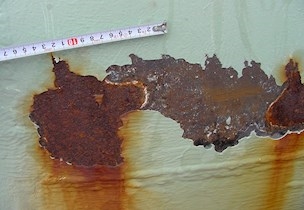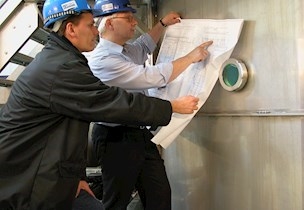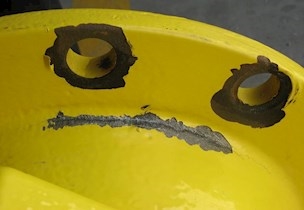FROSIO-certified coating inspection of steel structures
If you use a FROSIO-certified (NS 476)coating inspector, you ensure that the coating on your steel structure is well performed and stays intact and effectient for a long time.
Thus, you can save money for expensive and difficult repair processes on-site
Similarly, if your request is assessment of the state of existing coating and subsequent repair painting, we can assist you in obtaining the optimal process and quality, through our coating inspection.
Protect your steel structure against corrosion
Wind turbines, bridges and other steel structures are exposed to wind and weather that causes corrosion and reduce their service life. Paint and galvanization are used to protect steel surfaces against corrosion attacks, but if these coatings are not applied correctly, the protection is not effective.
Our FROSIO-certified coating inspector can inspect and approve the paint-work during the process. During the inspection, we identify and point out possible flaws and deficiencies for the surface provider to correct them immediately. Thus, we ensure good protection of your structure.
It is also far more economic to correct flaws and deficiencies during the production process than to repair them at a later point in the structure’s service life. Especially for the offshore sector where certain parts of the structures are often impossible to repair on-site, thus entailing a risk of a reduced service life.
Examples of flaws and deficiencies detected at a coating inspection, performed by our FROSIO-certified inspectors may be:- Too low paint film thickness and/or zinc coating
- Too high salt concentrations on steel surfaces
- Insufficient roughness of steel surface after sand blasting
- Dry spray where the paint does not form a coherent paint film before drying
- Insufficient cleaning of oil contamination on the surface
- Wrongly mixed paint, or storing too cold or too hot
- Too high humidity under paint application
- Dirt in the paint
- Poorly performed stripe coating so that the paint does not enter hard-to-access areas
- Pinholes or blisters in the hardened paint.
Coating inspection of intact and correctly applied paint
The paint inspection starts already during the preparatory work, when e.g. we check the steel structure for sharp edges, which may be difficult to cover with sufficiently thick coats, and surface flaws, which can impede efficient cleaning by sand blasting. The quantity of salts on the surface is also checked, as too high levels may lead to blisters in the coating later.
After blasting the paint inspector checks that the surface is clean, and that the roughness is adequate to ensure good adherence.
Temperature and relative humidity before, during and after application also have an impact on the durability of the coating. Therefore, the climate is checked several times during the process. This is particularly important when the painting takes place outdoor, or in other places where the climate cannot be controlled.
A coating is typically built up of more layers of paint including e.g. a zinc or aluminium-rich primer. Between each layer, and after the last layer, we check that the film thickness is correct, and that the coating has been applied without flaws, which may cause deterioration to its capability of protecting the structure.
A coating only protects as long as it is intact and adheres to the steel surface, and therefore we check the adherence properties of the fully cured coating – often on test plates produced for the occasion.
A satisfactory coating inspection ensures that your surface provider has performed his job correctly without deficiencies and that he has followed the specifications leaving your steel structure – regardless of it being a wind turbine, a bridge, a tank or something else – optimally protected against deterioration by corrosion.
FROSIO-certified inspectors
The training to become a FROSIO inspector is an internationally recognized education as per the Norwegian standard NS476, with a duration of 2 weeks, with a final theoretical as well as practical exam. Subsequently, the participant is classified at a level I-III, as per his/hers level of experience, as per which level IlI is the more experienced. The course certificate must be renewed after 5 years.
In the NORSOK M-501 standard this training compares with the NACE painting inspector training/education. This educational training includes corrosion protecting wet-enamelling and deals with quality assurance of all parts of the process from the substrate’s starting point to pre-treatment and selection of paint types to application of the paint, inspection methods in practice and current standards in the field.
Certified and professional inspection
FORCE Technology’s inspectors are all FROSIO-certified (NS 476) and independent, ensuring impartial and professional inspection of your coating.
As a starting point, the inspections are based on relevant norms and standards for coating, for instance DS/EN ISO 12944, DS/EN ISO 1461 and NORSOK M-501 and the requirements you have stated for the coating work in your specifications.
With a third-party inspection of the work, you ensure durable and lasting protection against corrosion.
Contact us if you have any questions regarding paint inspection or need to have your paintwork inspected.
Downloads
- Article: Offshore windfarms - successful corrosion protection combined with effective quality management
- Product sheet: When were you last inside the wind turbine?
- Brochure: Surface treatment - Consultancy and inspection
- Paper: EUROCORR 2014 Durability of coating repair systems for offshore services (pdf)
Services

Consultancy on specification for coating
Selecting an effective coating ensures a proper protection of your steel construction.

Organisation and planning of operation and maintenance
Avoid downtime and unexpected repair by organising and planning your maintenance.

Materials selection and corrosion protection
The correct materials and optimal corrosion protection gives your product a longer service life.

